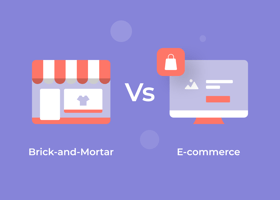In today's ever-evolving business landscape, the rise of ecommerce has disrupted traditional...
The E-commerce Dilemma: Digital vs. Physical Products
The world of e-commerce presents a fascinating choice between selling digital products and physical goods, each with its unique strengths. Understanding the Digital vs. Physical e-commerce landscape is essential for making informed decisions in the e-commerce market. In this article, we will break down both product avenues and share some industry insights.
Digital Products: The Digital Dynamo
Digital products, including e-books, software, and online courses, have carved a prominent niche in the e-commerce landscape. Their appeal lies in their unique attributes, making them a powerhouse in the digital realm. Let's explore exactly why digital can be a great option for some stores.
1. Boundless Reproduction and Scalability of Digital Products
One of the foremost advantages of digital products is their infinite reproducibility. Whether you sell one or a thousand copies, the production costs remain static. This scalability means that, with the right strategy, the potential for substantial profit margins is limitless. Scaling your digital product business is simply a matter of reaching more customers, without the need for additional manufacturing or shipping logistics.
2. Accessibility and Convenience for Consumers
From the consumer's perspective, digital products offer unparalleled convenience. Instant downloads mean no waiting for shipping, and the product is accessible on multiple devices. This convenience is a driving force behind the growth of subscription services, where customers can access a library of digital content for a monthly fee, contributing to recurring revenue.
3. Lower Overhead Costs and Environmental Responsibility
Digital products operate in an eco-friendly space. They reduce the need for physical resources such as paper and plastics, contributing to sustainability. This eco-conscious approach aligns with a growing environmental awareness and appeals to consumers who value eco-friendly choices. Moreover, lower overhead costs make running a digital product business lean and cost-effective.
Physical Products: The Tangible Touch
On the flip side, physical products, including clothing, electronics, and handcrafted items, hold a unique place in e-commerce. Their tangible nature offers distinct strengths that resonate with consumers seeking physical experiences. Now, let's talk about why physical is often the best choice when deciding product avenues for your store.
1. Tangible Connection and Multisensory Engagement
Physical products provide a tangible connection between customers and your brand. The act of holding a product, unboxing it, and experiencing its physicality can create a unique bond. This multisensory engagement evokes emotions and enhances the overall appeal of the product.
2. Diverse Market Opportunities and Personalization
The market for physical products is vast and diverse. From fashion to electronics, consumers actively seek out a wide array of physical items. This diversity means that sellers can tap into numerous niches and markets, catering to various tastes and preferences. Physical products also offer creative customization, from personalized engravings on jewelry to tailor-made furniture, adding perceived value and justifying premium pricing.
3. Cross-Channel Sales and Global Reach
Physical products can also be sold through various channels, including physical retail locations, pop-up shops, or at trade shows. This flexibility allows for cross-channel sales strategies, reaching consumers through various touchpoints. The physical realm offers opportunities to connect with global audiences effectively.
The Balance
In conclusion, the e-commerce arena offers a captivating duality, with digital products and physical goods each bringing their unique strengths. Understanding these strengths and finding the right balance that aligns with your business goals and customer base is the key to success. Savvy e-commerce entrepreneurs often integrate both, creating a diverse product catalog that appeals to a broad audience. The e-commerce world is vast and dynamic, offering a wealth of opportunities for those who understand the Digital vs. Physical e-commerce landscape.


